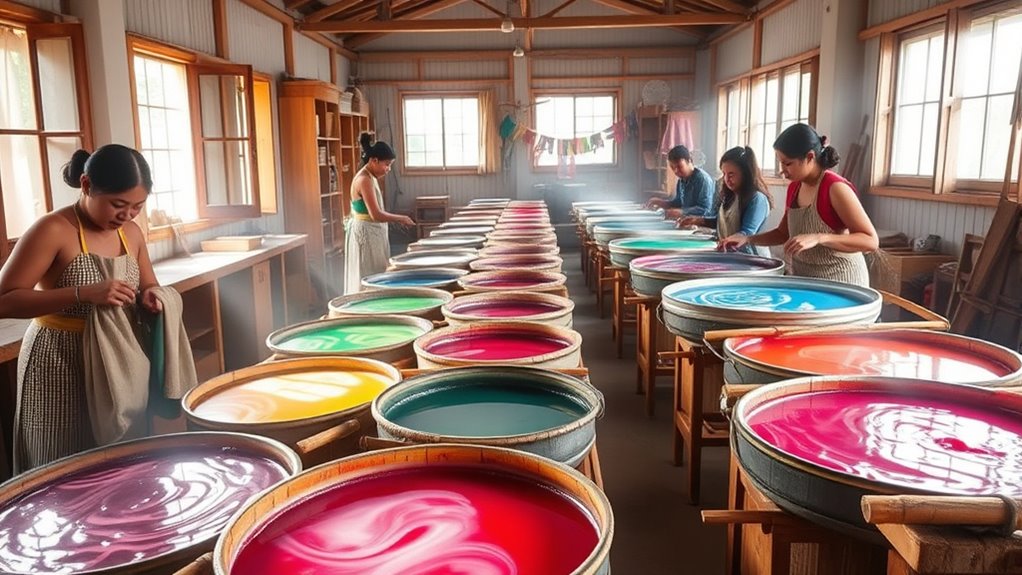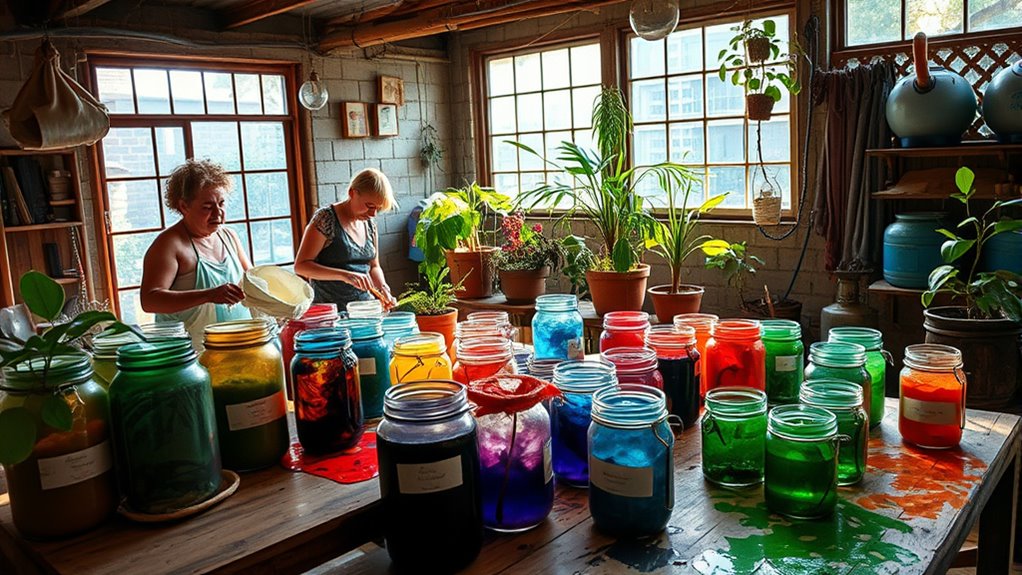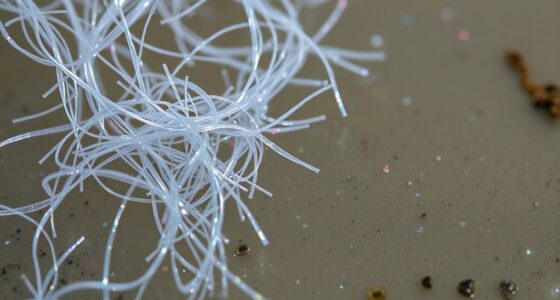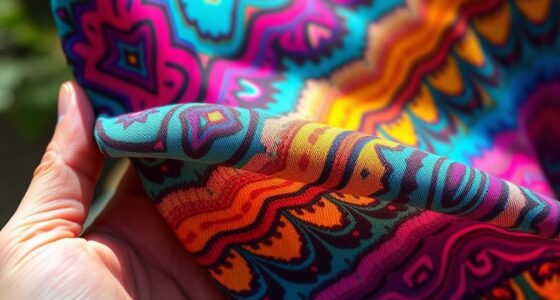Implementing rainwater harvesting in dyeing studios helps you conserve water, lower costs, and reduce environmental impact. By collecting rain from rooftops, you minimize reliance on municipal supplies and groundwater, supporting sustainable practices aligned with eco-friendly development goals. This approach not only boosts operational resilience during water shortages but also refines dyeing methods with chemical-free rainwater. To learn how this innovative strategy can transform your studio and inspire industry change, keep exploring what’s possible.
Key Takeaways
- Rainwater harvesting reduces reliance on municipal water, lowering costs and supporting sustainable dyeing practices.
- Using rainwater minimizes environmental impact by decreasing chemical runoff and wastewater generation.
- Incorporating rainwater systems enhances studio resilience during water shortages and promotes eco-friendly branding.
- Sustainable infrastructure and natural dyes align with global development goals, attracting eco-conscious consumers.
- Demonstrating industry leadership, rainwater-harvest dyeing studios inspire wider adoption of responsible water management in textiles.

Rainwater-harvest dyeing studios are transforming how we approach sustainable textile production. By tapping into rainwater, you can considerably reduce the reliance on traditional water sources, making water conservation a core part of your eco-friendly practices. Instead of drawing from municipal supplies or underground aquifers, you collect rainwater directly from rooftops or other catchment areas, storing it for use in your dyeing processes. This method not only conserves valuable freshwater resources but also minimizes your studio’s environmental footprint. As a result, you lower your water consumption, which is especially essential in regions facing water scarcity or drought conditions.
Rainwater harvesting reduces water use and environmental impact in sustainable textile dyeing.
Implementing rainwater harvesting in your dyeing studio allows you to adopt eco-friendly practices that align with sustainable development goals. You reduce the volume of wastewater generated, since rainwater is naturally soft and free of chemicals often found in tap water, which can interfere with dye uptake and color consistency. Using rainwater means you need less water treatment, further decreasing your energy use and chemical runoff. This approach promotes a closed-loop system where you reuse and recycle water, ensuring that your studio operates more sustainably overall.
Moreover, rainwater harvesting encourages you to rethink traditional dyeing methods. You can experiment with natural dyes and eco-friendly dyes that work best with rainwater, enhancing color vibrancy without harming the environment. This shift supports environmentally conscious branding and appeals to consumers who prioritize sustainability. Integrating rainwater harvesting into your workflow also helps you cut costs on water bills and reduces dependency on external water sources, giving your studio greater resilience during droughts or water restrictions.
Eco-friendly practices extend beyond water conservation. You can incorporate rainwater harvesting infrastructure into your studio’s design, using sustainable materials and energy-efficient systems. This not only demonstrates your commitment to environmental stewardship but also enhances your studio’s reputation among eco-conscious clients and partners. Educating your team and customers about these practices fosters a culture of sustainability, inspiring others in the industry to follow suit.
In addition, some regions with water scarcity issues are increasingly supporting the adoption of rainwater harvesting to ensure sustainable resource use. By embracing rainwater harvesting, you make a meaningful step toward sustainable textile production. You conserve water, reduce environmental impact, and adopt eco-friendly practices that serve both your business and the planet. This innovative approach exemplifies how small changes in resource management can lead to a more responsible, eco-conscious future for textile manufacturing. As you continue to refine and expand these practices, you position yourself at the forefront of a movement that values sustainability, innovation, and environmental respect.
Frequently Asked Questions
How Does Rainwater Harvesting Improve Dyeing Sustainability?
You can improve dyeing sustainability by using rainwater harvesting, which supports water conservation and promotes eco-friendly practices. By capturing and utilizing rainwater, you reduce reliance on groundwater or municipal supplies, decreasing environmental impact. This method helps lower water consumption, minimizes pollution, and maintains natural resources. Incorporating rainwater harvesting into your dyeing process makes your operations more sustainable, eco-conscious, and aligned with environmentally friendly standards, benefiting both your business and the planet.
What Types of Dyes Are Used in Rainwater-Harvest Dyeing Studios?
Imagine the vibrant colors you could create with dyes in these studios. You might expect only synthetic alternatives, but surprise awaits—natural dyes play a key role here. From plant-based indigos to mineral-rich ochres, these studios prioritize eco-friendly options. This blend of natural dyes and sustainable practices ensures vivid hues without harming the environment, making each piece not just colorful but also responsibly crafted.
How Do Studios Ensure Water Quality During the Dyeing Process?
You guarantee water quality by regularly conducting water testing to detect contaminants and maintain safety standards. You also install advanced filtration systems that remove impurities before dyeing begins, ensuring the water remains clean and suitable for eco-friendly dyeing processes. By consistently monitoring and filtering the water, you protect the integrity of your dyes and uphold sustainable practices, making sure the entire process stays environmentally responsible and high-quality.
What Are the Challenges of Implementing Rainwater Harvesting in Dye Studios?
They say, “Every cloud has a silver lining,” but implementing rainwater harvesting in dye studios isn’t that simple. You face cost barriers and infrastructure challenges, like installing storage systems and ensuring water quality. These hurdles require significant investment and planning, making it tough to adopt sustainable practices. Despite these obstacles, overcoming them can lead to greener operations and a more sustainable future for your studio.
How Can Other Businesses Adopt Rainwater-Based Dyeing Methods?
To adopt rainwater-based dyeing methods, you should focus on water conservation and community engagement. First, implement rainwater harvesting systems to reduce reliance on municipal water. Educate your team and community about sustainable practices, encouraging participation and support. By showcasing the environmental benefits, you foster a sense of shared responsibility, making your business a leader in eco-friendly dyeing. This approach boosts sustainability and builds positive community relationships.
Conclusion
By embracing rainwater-harvest dyeing studios, you become part of a vibrant movement that turns the tide against environmental harm. Imagine the colors of sustainability flowing through your work, transforming waste into art and scarcity into abundance. Just as rain nourishes the earth, your choices can nurture a greener future. So, step into this movement—where every drop counts—and let your passion for sustainable dyeing make a lasting impact that echoes far beyond the studio walls.










